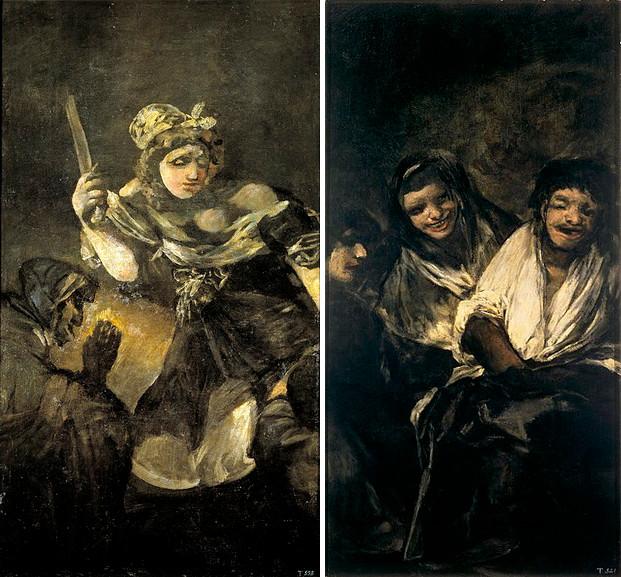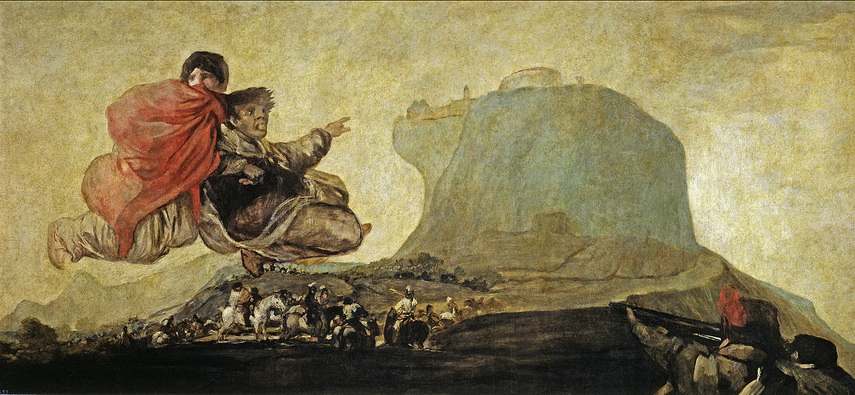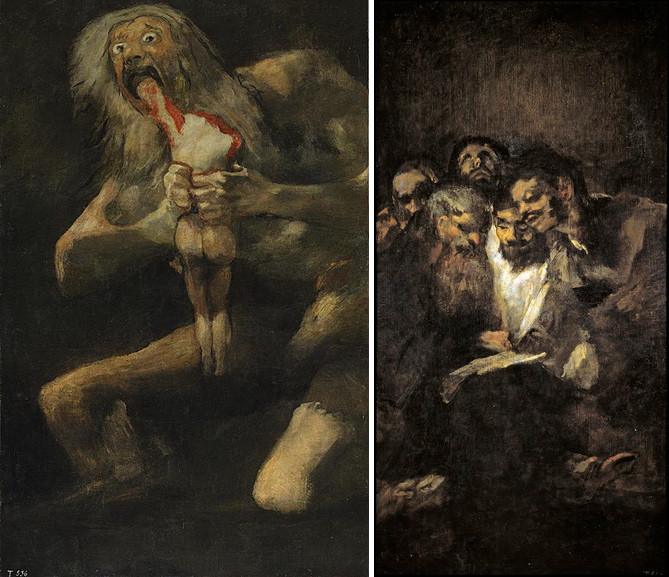The Mystery and Terror of Francisco Goya's Black Paintings
Looking from the contemporary perspective, the visual arts of the late 18th and the early 19th century could not be imagined without the presence of the last Old Master, Francisco Goya. This exceptional artist revolutionized the Spanish painting by making it truly critically charged. Without further delay, it can be said that Goya was genuinely radical, a person who experimented to the full extent while insisting that art is a reflection of the society. Now, to understand his oeuvre and especially his most daring series called the Black paintings made between 1819 and 1823, it is mandatory to understand the context of the times he lived and worked in.
The beginning of the 19th century was marked by the increasing change in the European geopolitical landscape. The most dominating factor was none other than Napoleon Bonaparte who conquered various territories, established firm intercontinental alliances, and imposed entirely modern reforms. In brief, the doings of this important historical figure provoked the birth of a new kind of political thought, or rather an ideology called nationalism.
When it comes to visual arts, the same period saw the emergence of Romanticism, which indeed was partly a response to the national awakenings. It was a movement focused on alienation, and the glorification of the past, especially the Medieval period; the Industrial Revolution was overlooked with skepticism, while the norms of the Age of Enlightenment, and the scientific rationalization of nature were critically articulated. Therefore, the impression is that Romanticism was at the same time modern and archaic, and this ambiguity makes it even more interesting.
Although the painting of Goya is often interpreted under Romanticism, it is quite hard to put it within constraints of this particular movement. In this article, we will analyze the mentioned Black paintings which perfectly illustrate not only Goya’s immense craftsmanship, but also his firm belief that painting should and could change the society, or at least critically articulate it.

The Creation of The Black Paintings
This astonishing series of fourteen paintings belonging to the Pinturas negras feature haunting, almost ghoulish themes reflecting the surplus of Goya’s bitter observations on humanity. Namely, in 1819 the artist moved to a house located on the brinks of Madrid called Quinta del Sordo (Deaf Man's Villa), and at that point, he was already a senior (at the age of 72) and almost deaf himself. Initially, the paintings were painted as murals on the walls of the house, and later they were transferred from the walls and attached to the canvas.
The series can be observed in the context of the Peninsular War fought by Napoleon against Spain. Throughout the war, Goya remained in Madrid where he faced fear, panic, terror, and hysteria. The artist also went through near-fatal illnesses twice and was exposed to constant anxiety and fear. By having these facts in mind, it is easier to understand what made Goya produce the Black Paintings. After all, it wasn’t a commissioned work, meaning that the artist had an urge to express his torment through his works at peace in his home.
Interestingly so, Goya didn’t title the paintings, and the majority of the names used are designations imposed by art historians, though in 1828 Goya’s friend, Antonio Brugada cataloged the works. Now these fourteen paintings are known under the following titles: Two Old Men, Atropos (The Fates), Two Old Men Eating Soup, Fight with Cudgels, Witches' Sabbath, Men Reading, Judith and Holofernes, Saturn Devouring His Son, A Pilgrimage to San Isidro, Women Laughing, Procession of the Holy Office, The Dog, La Leocadia, and Fantastic Vision.
The Quinta del Sordo villa is located on the banks of the River Manzanares, and it seems that the artist purchased the house to escape from public life. There he lived with Leocadia Weiss, although she was still married to another. There isn’t any specific indication as to when the series is started, but according to the scholars that might be between February and November 1819. Whichever the case, the compositions were based on the rural scenes and small figures, since Goya used the surrounding landscapes.
The Black Paintings murals were probably finished no later than 1823 when Goya traveled to Bordeaux and left the villa to his grandson Mariano who then passed the ownership of the villa to his father Javier de Goya in 1830. In 1874 the transferring process of the murals onto canvas began. Goya painted the murals over the top of wallpapers which covered the walls of the villa, so they had to be carefully removed and applied to the canvas. This procedure was conducted under the supervision of Salvador Martínez Cubells at the request of a French banker of German origins, Baron Émile d’Erlanger; he wanted to sell the paintings at the Paris World's Fair in 1878, but instead, the baron decided to donate the paintings to the Spanish state.
According to the written testimonies regarding the original status of the murals and from an photographic inventory made by Jean Laurent in 1874, the ground floor was a rectangular space with two windows near the shorter walls and two large murals in the form of landscapes in between (A Pilgrimage to San Isidro, and on the right and Witches' Sabbath on the left). On the smaller wall opposite the entrance, there was a window in the center with Saturn Devouring His Son on the left, Judith and Holofernes on the right, and La Leocadia on one side of the door (opposite Saturn) and Two Old Men was opposite Judith.
The first floor was the same size as the ground floor with one central window in the long walls and a mural on each side. Fantastic Vision covered the right wall nearest to the entrance with Procession of the Holy Office beyond the window. On the left were Atropos (The Fates) and Fight with Cudgels, while the short wall was covered with Women Laughing on the right and Men Reading on the left. To the right of the door was The Dog and to the left Heads in a landscape, while Two Old Men Eating Soup was located above one of the doors.

The Themes and Motifs
The Black Paintings palette is based on darker shades of ochre, gold, brown, grey and black. Goya used the white only to accentuate the contrast the clothes, occasional strokes of blue for the sky and green for a landscape.
One of the best known of the Black Paintings is Saturn Devouring His Son. The image is based on a myth of the Titan Kronos, father of Zeus, eating one of his children since he was afraid of the prophecy that one would come to overthrow him. Goya depicted this theme in a raw and unsettling manner by accentuating the savagery of the horrific and merciless act. There is also a painting called Witches' Sabbath, or The Great He-Goat, which is even darker than the previous one as it features an ancient, pagan belief that during the Sabbath, witches meet summoned by the Devil in form of a goat.
There are numerous interpretations of the series, but according to the dominating propositions, Goya made the paintings contrary to the décor found in the nobility palaces of the time. The rules suggested that paintings should complement the environment, meaning that each room should be decorated accordingly with country scenes, still life paintings and representations of banquets depending on their function. Goya ignored those rules and, for instance, he painted the act of eating in Saturn Devouring His Son and Two Old Men Eating Soup in a manner of black humor.
On the other hand, the paintings on the first floor underline the contrast between tears and laughter - the serious atmosphere of Men Reading is contrasted by Women Laughing. In the same way function the mythological scenes of Fantastic Vision and The Fates representing tragedy, and the satirical painting Procession of the Holy Office.
Looking from the compositional perspective these paintings were quite innovative; Goya achieved that by incorporating the figures off-center in an unbalanced fashion. The other novelty is the fact all the compositions are indeed nocturnal and generate an otherworldly, oneiric atmosphere.

The Importance of The Black Paintings by Goya
It is apparent that the Black Paintings series show Goya’a anguish and in general his psychological decline due to the illness, aging and the complicated relation with a younger woman. The artist wisely managed to combine his personal struggle with the social issues he perceived as troubling, such as the pilgrimages, processions, the Inquisition and civil confrontations caused by political upheavals.
It should also be said that the Black Paintings were made during the period when Spain was ruled by a liberal government which lasted from 1820 to 1823; this once again changed with the restoration of absolute monarchy.
Today, Goya's The Black Paintings are on permanent display at the Museo del Prado. Although they were quite damaged in the first place due to the delicate operation of transferal to canvas, this series marked a milestone of Goya’s entire practice and is considered as a grandiose testimony of the great artist, a proof of his genius and care for the well-being of humanity.
The Black Paintings of Francisco Goya: Dark Horror History of Art
> Editors’ Tip: Goya: Order & Disorder
Francisco Goya has been widely celebrated as the most important Spanish artist of the late-eighteenth and early nineteenth centuries, the last of the old masters and the first of the moderns, and an astute observer of the human condition in all its complexity. The many-layered and shifting meanings of his work have made him one of the most studied artists in the world. Few, however, have made the ambitious attempt to explore his work as a painter, printmaker and draftsman across media and the timeline of his life. This book does just that, presenting a comprehensive and integrated view of Goya's most important paintings, prints, and drawings through the themes and imagery that continually challenged or preoccupied the artist. They reveal how he strove relentlessly to understand and describe human behavior and emotional states, even at their most orderly or disorderly extremes, in elegant and incisive portraits, dramatic and monumental history paintings, and series of prints and drawings of a satirical, disturbing and surreal nature.
Featured image: Francisco Goya - Two Old Men Eating Soup (Dos viejos comiendo sopa), between 1819 and 1823. Oil on canvas. 49.3 cm (19.4 in) x 83.4 cm (32.8 in); Átropos o Las Parcas, between 1819 and 1823. Oil mural painting moved to canvas. Mixed media on wallcovering, 123 cm (48.4 in x 266 cm (104.7 in); El Aquelarre, between 1821 and 1823; El Santo Oficio, between 1819 and 1823. Oil on wall moved to canvas, 123 x 266 cm; Fight with Cudgels, 1820-1823. Oil on canvas, 125 x 261 cm; La romería de San Isidro, between 1819 and 1823. Oil on wall moved to canvas. 140 x 438 cm. Museo del Prado. All images via Wikimedia Commons.
Can We Help?
Have a question or a technical issue? Want to learn more about our services to art dealers? Let us know and you'll hear from us within the next 24 hours.

